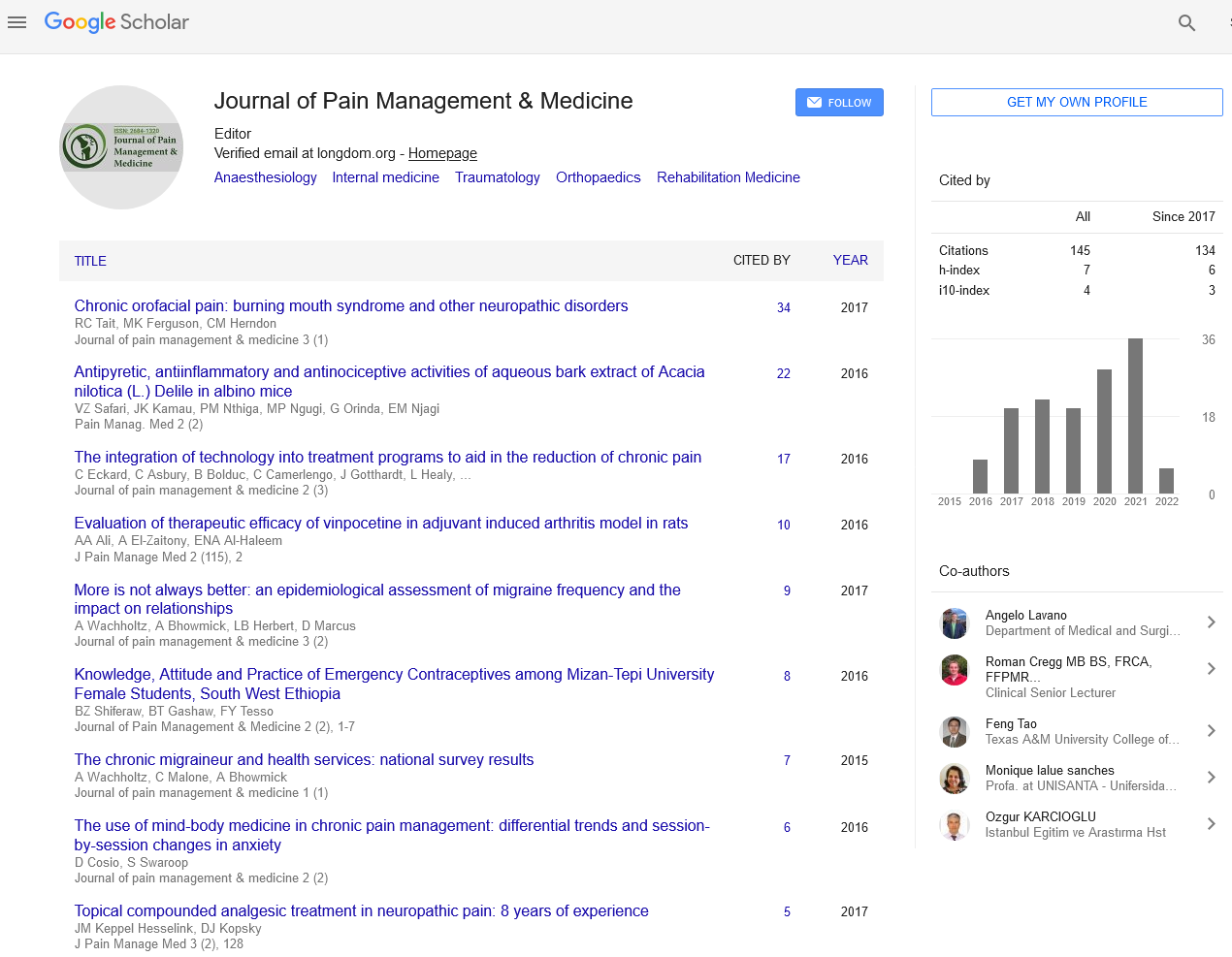Indexed In
- RefSeek
- Hamdard University
- EBSCO A-Z
- Publons
- Euro Pub
- Google Scholar
- Quality Open Access Market
Useful Links
Share This Page
Journal Flyer

Open Access Journals
- Agri and Aquaculture
- Biochemistry
- Bioinformatics & Systems Biology
- Business & Management
- Chemistry
- Clinical Sciences
- Engineering
- Food & Nutrition
- General Science
- Genetics & Molecular Biology
- Immunology & Microbiology
- Medical Sciences
- Neuroscience & Psychology
- Nursing & Health Care
- Pharmaceutical Sciences
Perspective - (2023) Volume 9, Issue 4
Neck Pain: Causes, Management, and Prevention
Amin Carrillo*Received: 02-Jul-2023, Manuscript No. JPMME-23-22859; Editor assigned: 04-Jul-2023, Pre QC No. JPMME-23-22859 (PQ); Reviewed: 18-Jul-2023, QC No. JPMME-23-22859; Revised: 25-Jul-2023, Manuscript No. JPMME-23-22859 (R); Published: 04-Aug-2023, DOI: 10.35248/2684-1320.23.9.222
Description
Neck pain is a common condition that affects individuals of all ages and lifestyles; it can significantly reduce quality of life by effecting daily activities, reducing mobility, and causing pain. From mild tension to debilitating pain, neck pain can develop from various factors, including poor posture, muscle strain, injuries, and underlying medical conditions.
Spectrum of neck pain
Neck pain encompasses a wide spectrum of discomfort, ranging from occasional twinges to persistent agony. It frequently presents as stiffness, aching, or sharp pain in the neck area, and can radiate to the shoulders, upper back, and arms. Neck pain can be acute, extending several days or weeks, or chronic, enduring for three months or longer. The impact of neck pain causes the physical existence, affecting emotional well-being and overall functionality.
Causes and contributors
Several factors contribute to the development of neck pain:
Poor posture: Modern lifestyles involving prolonged sitting and hunching over electronic devices contribute to poor neck posture, straining the muscles and ligaments.
Muscle strain: Excessive effort, repetitive movements, and sudden movements can lead to muscle strain in the neck.
Injuries: Accidents, falls, and sports-related impacts can cause injuries, such as whiplash a sudden forward and backward motion of the head resulting in neck pain.
Degenerative conditions: Conditions such as osteoarthritis and degenerative disc disease can result in gradual breakdown of neck structures, causing pain and reduced mobility.
Nerve compression: Herniated discs or bone spurs can compress nerves in the neck, leading to pain that radiates down the arm, known as cervical radiculopathy.
Medical conditions: Fundamental medical conditions such as fibromyalgia, meningitis, and heart attack can also manifest as neck pain.
Management and treatment
The management of neck pain involves a combination of techniques tailored to the individual's specific condition and needs:
Rest and activity modification: Adequate rest allows muscles to heal, but extended inactivity can worsen pain. Gradually reintroducing movement and maintaining perfect alignment are essential.
Physical therapy: Therapeutic exercises and stretches prescribed by a physical therapist can improve muscle strength, flexibility, and overall neck function.
Medications: Pain relievers, muscle relaxants, and antiinflammatory drugs can provide temporary relief. Prescription medications may be recommended for severe pain.
Heat and cold therapy: Applying heat or cold to the affected area it can help to reduce pain and inflammation. Cold therapy is usually recommended for acute injuries, while heat is more suitable for chronic muscle tension.
Manual therapy: Techniques such as chiropractic adjustments and massage therapy can alleviate muscle tension and improve spinal alignment.
Ergonomic changes: Developing organizations, using ergonomic chairs, and maintaining proper posture while using electronic devices can prevent neck strain.
Alternative therapies: Acupuncture, yoga, and mindfulness practices have demonstrated effectiveness in managing chronic neck pain by addressing both physical and emotional aspects.
Prevention for a healthy neck
Preventing neck pain involves adopting habits and practices that increase neck health:
Maintain good posture: Maintain proper spinal alignment whether sitting, standing, or using technological devices. Align the neck, spine, and shoulders in a neutral position.
Stay active: Engage in regular physical activity to maintain neck muscles strong and flexible. Incorporate exercises that target neck and shoulder muscles.
Medical attention
While many cases of neck pain can be managed with self-care and conservative measures, some conditions necessitate immediate medical attention:
Severe pain: Intense, unrelenting pain or pain accompanied by weakness, numbness, or tingling in the arms or hands should be evaluated by a healthcare professional.
Trauma: If neck pain follows an accident or injury, obtain medical assistance to evaluate for major conditions such as fractures or dislocations.
Progressive symptoms: If neck pain improves continuously or it is accompanied by significant reduction in weight or illness, consult a healthcare provider.
Neck pain is a common and diverse condition that can originate from various causes, impacting individuals' physical and emotional well-being. A comprehensive technique to managing and preventing neck pain involves adopting healthy habits, obtaining guidance from professionals when necessary, and addressing contributing factors. By analyzing the complexities of neck pain and implementing preventive measures, individuals can aim to maintain a pain-free and active lifestyle, eventually improving their overall quality of life.
Citation: Carrillo A (2023) Neck Pain: Causes, Management, and Prevention. J Pain Manage Med.9:222.
Copyright: © 2023 Carrillo A. This is an open access article distributed under the terms of the Creative Commons Attribution License, which permits unrestricted use, distribution, and reproduction in any medium, provided the original author and source are credited.


